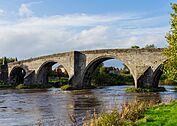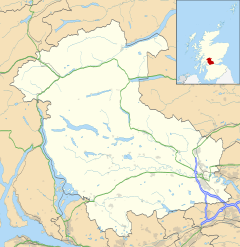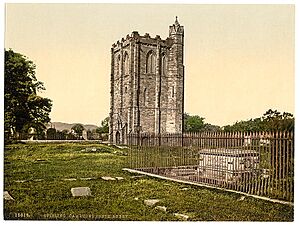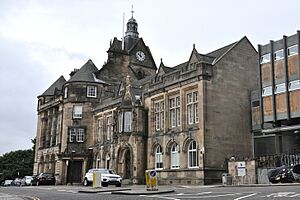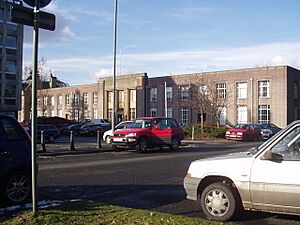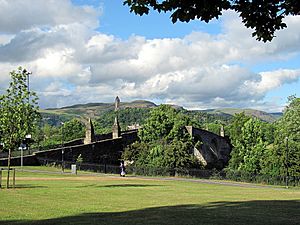Stirling facts for kids
Quick facts for kids Stirling
|
|
|---|---|
| City | |
|
The skyline of Stirling, with the castle at the top of the hill and Stùc a' Chroin mountain behind
Stirling Old Bridge
Robert the Bruce statue
|
|
| Population | 37,910 ((mid-2016 est.)) |
| Council area | |
| Lieutenancy area |
|
| Country | Scotland |
| Sovereign state | United Kingdom |
| Post town | STIRLING |
| Postcode district | FK7–FK9 |
| Dialling code | 01786 |
| Police | Central Scotland |
| Fire | Central Scotland |
| Ambulance | Scottish |
| EU Parliament | Scotland |
Stirling is a historic city located in central Scotland. It is about 26 miles (42 km) northeast of Glasgow and 37 miles (60 km) north-west of Edinburgh. Stirling started as a busy market town. It grew around the royal Stirling Castle, the old medieval town, and the Stirling Old Bridge over the River Forth.
Stirling is known as the "Gateway to the Highlands." This means it's a key spot where the flat Scottish Lowlands meet the rugged Scottish Highlands. People used to say, "He who holds Stirling, holds Scotland." This shows how important its location was for controlling the country.
The city's position was vital because it was the lowest point where the River Forth could be crossed. This made it a central place for travel and trade. An old story from the 9th century says that a wolf saved Stirling from Danish invaders. The wolf's howl woke a guard, who alerted the town. This led to the Vikings retreating. Because of this, a wolf became a symbol of Stirling. You can still see the wolf on the city's coat of arms today.
Stirling was once the capital of Scotland. It is famous for Stirling Castle, which sits high on a hill. The city also has the Church of the Holy Rude, a very old church. In 1567, James VI was crowned King of Scots there when he was just a baby. Stirling is now a busy center for local government, universities, tourism, shopping, and businesses. In 2012, about 36,440 people lived in the city. The wider Stirling area has about 93,750 residents.
King David I made Stirling a "royal burgh" in 1130. This was a special town with royal rights. In 2002, during Queen Elizabeth's Golden Jubilee, Stirling officially became a city.
Contents
- What's in a Name? The Meaning of Stirling
- Stirling's Long History
- How Stirling is Governed
- Stirling's Geography
- People of Stirling
- Stirling's Culture and Fun
- Places of Worship
- Stirling's Economy
- Getting Around Stirling
- Media in Stirling
- Sports and Fun Activities
- Learning and Education
- Cities Stirling is Connected To
- Famous People from Stirling
- Freedom of the City
- Images for kids
- See also
What's in a Name? The Meaning of Stirling
The name Stirling has changed over time. It was once called Strivelin(g) and Stirveling. Experts have debated what the name means and where it comes from. Many now believe it comes from the Scottish Gaelic words srib-linn. This means "pool in the river," which makes sense because of the River Forth.
An old book from the 8th century, written by Bede, mentions a place called urbs Giudi. This means "the town of Giudi." Many scholars think this old town was Stirling. The name Giudi is thought to be Celtic.
Stirling's Long History
Early Times: Ancient Discoveries
Stirling has a very long history. The oldest item found here is a stone cist (a stone box for burial). It was found in 1879 and contained bones that are over 4,000 years old. This person, nicknamed Torbrex Tam, was in his twenties when he died. Other Bronze Age finds have been made near Cambusbarron.
The oldest known buildings in Stirling are now gone. They were two Neolithic Cursus (long earthworks) in Bannockburn. The oldest surviving building is an Iron Age fort on Gillies Hill. It was built by people over 2,000 years ago. There are also ancient carvings in King's Park, south of the city.
Roman Times and the Middle Ages
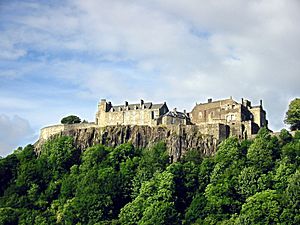
Stirling's location near the lowest crossing point of the River Forth was very important. Controlling the bridge gave military power and allowed taxes to be collected from traders. This tax was called "pontage dues." Stirling was the easiest place to cross the river until a new bridge was built in 1885.
Stirling has two Latin mottoes on its old town seal. One motto talks about a cross on the first stone bridge. It says: "Hic Armis Bruti Scoti Stant Hic Cruce Tuti." This means: "Brits and Scots armed and near, by this cross stand safe here." It suggests that the people from the Lowlands and Highlands were protected from each other by their shared Christian faith.
The second motto is: "Continet Hoc in Se Nemus et Castrum Strivelinse." This means: "Contained within this seal pressed down, the wood and castle of Stirling town."
Stirling became a "royal burgh" in the 12th century, given this special status by King David. The ferry and later the bridge over the River Forth brought wealth and power to the town.
Major battles during the Wars of Scottish Independence happened here. The Battle of Stirling Bridge in 1297 involved Andrew Moray and William Wallace. The Battle of Bannockburn in 1314 involved Robert the Bruce. After the Battle of Stirling Bridge, Wallace encouraged trade between Scotland and German ports. Stirling Castle was also attacked many times during these wars.
Later History: Kings, Wars, and Trade
Another important historical place is the ruins of Cambuskenneth Abbey. This is where King James III and his queen, Margaret of Denmark, are buried.
Stirling played a role in the Wars of the Three Kingdoms in 1648. Later, during the Jacobite risings in the 18th century, the castle was a key military spot. In 1746, Bonnie Prince Charlie's army took the town but could not capture the castle. As they left, they blew up the church of St. Ninians, leaving only its tower.

The Church of the Holy Rude is one of Stirling's most important buildings. It was founded in 1129 and rebuilt in the 15th century after a big fire. It is one of the few churches in the UK where a king was crowned. On July 29, 1567, Mary, Queen of Scots' baby son was crowned James VI of Scotland here. You can still see marks on the church tower from musket shots, possibly from Oliver Cromwell's soldiers.
Stirling's port was important for trade with other countries. It traded a lot with places like Bruges in Belgium and Veere in the Netherlands. In the 16th century, there were many Scots living in Danzig (now in Poland) because of trade.
Before railways, cattle drovers used the Old Bridge. They moved thousands of cattle, sheep, and ponies to markets in the south. Sometimes, there was a four-mile long line of livestock trying to cross!
Modern Stirling: From Steamboats to Today
In the early 1800s, steamboats traveled between Stirling and Newhaven. But when railways arrived in 1848, river traffic declined. The railways, however, brought new opportunities. One company in Riverside sold reaping machines as far away as Syria and Australia. Another company, started in 1861, made baby carriages that were sent all over the world.
The Municipal Buildings, which were the main offices for Stirling's council for much of the 20th century, were finished in 1918. After the World Wars, the port saw some increase in use, including tea trade with India. But by the mid-20th century, the port closed because railways made shipping by river less profitable.
How Stirling is Governed
Stirling is part of the larger Stirling Council area. The council manages local services and is based at Old Viewforth. Council members are elected every five years. In 2017, the Scottish Conservative party and Scottish National Party each won nine councillors. The Labour Party won four seats, and the Scottish Green Party won one. The head of the council is called the Provost.
For the Scottish Parliament, Stirling is part of the Stirling constituency. People in this area elect one Member of the Scottish Parliament (MSP). The current MSP for Stirling is Evelyn Tweed from the Scottish National Party (SNP).
For the UK Parliament, Stirling is part of the Stirling and Strathallan area. This area elects one Member of Parliament (MP) to the House of Commons. The current MP is Chris Kane from the Labour Party.
Stirling's Geography
Stirling is known as the "Gateway to the Highlands." It sits where the flat Scottish Lowlands meet the rugged Scottish Highlands. You can see mountains like Ben Vorlich and Ben Ledi to the northwest. To the east, the Carse of Stirling is a very flat and fertile area.
The city grew around Stirling Castle, which is on a strong defensive hill called the Stirling Sill. This hill is made of quartz-dolerite. Stirling is also on the River Forth, where the river becomes wider and affected by tides. East of the city, the Ochil Hills are visible, with Dumyat being a noticeable peak. The Abbey Craig, a hill with the Wallace Monument on top, is also a famous landmark.
Areas of Stirling
Top of the Town is the historic part of Stirling. It includes streets like Broad Street, Castle Wynd, and Baker Street. These streets lead up to Stirling Castle. Tourists love this area, visiting the Old Town Jail, Mar's Wark, and Argyll's Lodging. The streets here are cobblestoned, and you can hear cars rattling over them. From the top, you get amazing views of Stirling.
Other areas in Stirling include:
- Abbey Craig
- Airthrey
- Allan Park
- Back o' Hill
- Bannockburn
- Borestone
- Braehead
- Bridgehaugh
- Broomridge
- Brucefields
- Burghmuir
- Cambusbarron
- Cambuskenneth
- Causewayhead
- Chartershall
- Corn Exchange
- Cornton
- Coxethill
- Craigforth
- Craigmill
- Craig Leith
- Cultenhove
- Dumyat
- Forthbank
- Gillies Hill
- Gowan Hill
- Hillpark
- Kenningknowes
- Kersemill
- Kildean
- King's Park
- Ladyneuk
- Laurelhill
- Livilands
- Loanhead
- Logie
- Mote Hill
- Meadowforth
- Mercat Cross
- Pirnhall
- Queenshaugh
- Raploch
- Randolphfield
- Riverside
- Spittal Hill
- Springkerse
- St. Ninians
- Top of the Town
- Torbrex
- Whins of Milton
- Viewforth
- Westhaugh
- Wolfcraig
Stirling's Weather
Stirling has a mild climate, like most of the United Kingdom. Summers are mild, and winters are cool and wet. Stirling often has some of the warmest summers in Scotland. This is because it is not very close to the cooling effects of the North Sea or the Firth of Clyde.
| Climate data for Stirling (1991–2020 averages, extremes 2009–present, [25 m or 82 ft asl]) | |||||||||||||
|---|---|---|---|---|---|---|---|---|---|---|---|---|---|
| Month | Jan | Feb | Mar | Apr | May | Jun | Jul | Aug | Sep | Oct | Nov | Dec | Year |
| Record high °C (°F) | 13.6 (56.5) |
15.5 (59.9) |
17.1 (62.8) |
21.1 (70.0) |
27.8 (82.0) |
32.3 (90.1) |
29.0 (84.2) |
24.9 (76.8) |
23.8 (74.8) |
19.7 (67.5) |
15.7 (60.3) |
14.5 (58.1) |
32.3 (90.1) |
| Mean daily maximum °C (°F) | 7.3 (45.1) |
8.1 (46.6) |
9.9 (49.8) |
12.4 (54.3) |
15.7 (60.3) |
18.1 (64.6) |
19.9 (67.8) |
19.5 (67.1) |
17.1 (62.8) |
13.5 (56.3) |
10.0 (50.0) |
7.5 (45.5) |
13.3 (55.9) |
| Daily mean °C (°F) | 4.4 (39.9) |
5.0 (41.0) |
6.4 (43.5) |
8.3 (46.9) |
11.3 (52.3) |
14.0 (57.2) |
15.7 (60.3) |
15.3 (59.5) |
12.9 (55.2) |
9.8 (49.6) |
6.7 (44.1) |
4.3 (39.7) |
9.5 (49.1) |
| Mean daily minimum °C (°F) | 1.4 (34.5) |
1.9 (35.4) |
2.9 (37.2) |
4.3 (39.7) |
6.9 (44.4) |
9.8 (49.6) |
11.5 (52.7) |
11.1 (52.0) |
8.8 (47.8) |
6.2 (43.2) |
3.5 (38.3) |
1.1 (34.0) |
5.8 (42.4) |
| Record low °C (°F) | −11.1 (12.0) |
−7.6 (18.3) |
−5.8 (21.6) |
−3.9 (25.0) |
−1.7 (28.9) |
3.6 (38.5) |
5.0 (41.0) |
3.8 (38.8) |
1.0 (33.8) |
−2.8 (27.0) |
−6.6 (20.1) |
−15.6 (3.9) |
−15.6 (3.9) |
| Average rainfall mm (inches) | 129.3 (5.09) |
97.3 (3.83) |
74.5 (2.93) |
51.4 (2.02) |
56.9 (2.24) |
66.6 (2.62) |
70.1 (2.76) |
76.1 (3.00) |
76.3 (3.00) |
107.4 (4.23) |
109.2 (4.30) |
103.1 (4.06) |
1,018.1 (40.08) |
| Average rainy days (≥ 1 mm) | 16.3 | 13.6 | 12.8 | 10.6 | 11.3 | 11.7 | 13.0 | 13.0 | 12.6 | 15.2 | 16.1 | 15.4 | 161.4 |
| Mean monthly sunshine hours | 39.1 | 66.9 | 99.5 | 137.8 | 183.1 | 162.0 | 153.7 | 150.5 | 119.5 | 81.3 | 54.0 | 32.2 | 1,279.6 |
| Source: MetOffice | |||||||||||||
People of Stirling
In 2012, the city of Stirling had a population of 48,440 people. Slightly more than half (52.7%) were female, and 47.2% were male. Stirling has a smaller percentage of people under 16 (16.7%) compared to the average for Scotland (19.2%). It also has fewer people of retirement age (17.8%) than the Scottish average (18.6%).
Stirling's Culture and Fun
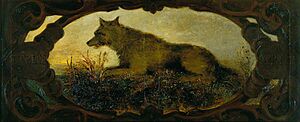
A very old custom in Stirling is "Walking the Marches." This started in the 12th century. People would walk around the town's borders each year to check and protect them. This tradition was brought back in 2014.
Stirling has about sixteen libraries and two mobile libraries. The Smith Art Gallery and Museum is free to visit for everyone. It's a great place to spend a few hours. The Macrobert Arts Centre offers many shows and exhibitions. There are also events at the Stirling Tolbooth and The Albert Halls. Stirling has hosted the Royal National Mòd (a Scottish Gaelic festival) several times.
Places of Worship
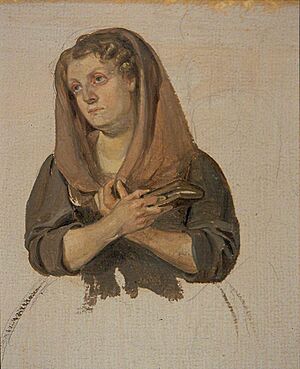

Stirling has about 20 churches. These include:
- Allan Park South Church
- Cambusbarron Parish Church
- Church of the Holy Rude
- North Parish Church
- St Columba's Church
- St Mark's Parish Church
- St Ninians Old Parish Church
- Viewfield Church
Roman Catholic
- Holy Spirit, St. Ninians
- Our Lady and St Ninian's, Bannockburn
- St Margaret of Scotland and Holy Spirit, Raploch
- St Mary's Church, Top of the Town
Other churches
- Cornerstone Community Church
- Cornton Baptist Church
- Holy Trinity Episcopal Church
- St Ninians United Free Church of Scotland
- Stirling Baptist Church
- Stirling Free Church
- Stirling Methodist Church
- St. Ninian's Community Church
- The Salvation Army
Islam
- Central Scotland Islamic Centre
Stirling's Economy
Stirling is a market town and a transport hub. This means it has a large shopping area. You'll find many chain stores and the Thistles shopping centre in the city center. There are also shops outside the city center, like the Springkerse Retail Park.
A big new project called Forthside is happening near the old port and Stirling Railway Station. This project aims to create a new waterfront area with shops, homes, and businesses. It will include a conference center, a hotel, and a cinema. This will connect the city center to the River Forth again.
In the service industry, financial services and tourism are major employers. A large financial company, Scottish Amicable Life Assurance (now part of Prudential), has offices on the edge of Stirling.
Tourism is very important because of places like Stirling Castle and the Wallace Monument. Other nearby attractions, like Blair Drummond Safari Park, also bring many visitors to Stirling.
The University of Stirling and Stirling Council are two of the biggest employers in the area. Companies focused on knowledge, research, and science have set up near the university at the Stirling University Innovation Park.
In 2009, a survey found that workers in Stirling had the highest average earnings in Scotland.
Getting Around Stirling
Many people travel into Stirling for work. About half of Scotland's population lives within an hour's travel of the city.
Local buses run throughout the city, mainly by McGill's Scotland East. Buses also connect Stirling to nearby towns like Bridge of Allan, Alloa, Falkirk, and Glasgow.
Coaches also run regularly to many other Scottish towns and cities.
Stirling has good railway links from Stirling railway station. You can catch trains to Aberdeen, Dundee, Edinburgh Waverley, Inverness, Glasgow Queen Street, and London King's Cross. There are also services to Alloa, Bridge of Allan, Falkirk, and Dunblane.
Stirling is close to major motorways. The M80 motorway connects to Glasgow, and the M9 motorway connects to Edinburgh and to Perth in the north.
Stirling does not have an airport. However, Glasgow and Edinburgh international airports are less than an hour away.
Media in Stirling
Stirling has local radio stations like CastleSound and Air3 Radio. Air3 Radio is run by students from the University of Stirling.
The Stirling News and Stirling Observer are the local newspapers for the city.
Sports and Fun Activities
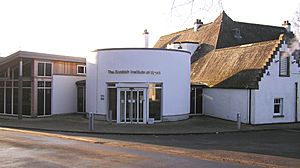
Stirling has professional sports teams in football, rugby, and cricket. The first Stirling Scottish Marathon was held in 2017. The National Curling Academy is in Stirling Sports Village. It opened in 2017 and aims to help British athletes win medals in events like the Winter Olympics.
The main football team, Stirling Albion, plays at Forthbank Stadium. In 2010, the club became the first fully community-owned football club in Britain. Stirling University L.F.C. is the top women's football team. Famous Scottish footballers like Billy Bremner and Duncan Ferguson were born in Stirling. Rugby players Kenny Logan and Ally Hogg, jockey Willie Carson, and cricketer Dougie Brown are also from Stirling.
Stirling County plays in Scotland's top rugby league. The Stirling Knights Basketball Team are based at The Peak. The Central Athletic Club is at the University of Stirling.
The University of Stirling is a major center for sports in Scotland. It was named Scotland's University for Sporting Excellence in 2008. The Scottish Institute of Sport has its headquarters there. The Scottish National Swimming Academy is also at the university. Olympic medalists like Duncan Scott and Robbie Renwick trained there. The university's tennis center is where Andy Murray and his brother Jamie Murray learned their skills.
The university has a special department for sports studies. It is known for having excellent sports facilities. Stirling and the surrounding area have several golf courses. The Peak, a new Sports Village, opened in 2009.
In 2014, Stirling became the home of Scottish cricket. The ground at New Williamfield is being upgraded to host international matches.
Learning and Education
The University of Stirling opened in 1967. It has about 11,100 students, with many coming from other countries. It is a big research center with an Innovation Park next to the campus. This park has 40 companies doing research and development. Students from Singapore can even get degrees from the University of Stirling through a partnership. Stirling is also home to part of the Forth Valley College.
There are four main high schools in Stirling: Stirling High School, Wallace High School, St Modan's High School, and Bannockburn High School. All these schools have been rebuilt or improved. Riverside Primary School in Stirling has a special unit that teaches children in Scottish Gaelic. Queen Victoria School, a school for children of military families, is also in Stirling.
Cities Stirling is Connected To
Stirling is twinned with several cities around the world. This means they have special friendly relationships.
- Villeneuve d'Ascq, France
- Dunedin, Florida, United States
- Óbuda, Hungary
- Summerside, Prince Edward Island, Canada
- Kecioren, Turkey
Famous People from Stirling
Many notable people have lived in or are from Stirling:
- Dorothy Angus, embroidery artist
- Frank and Harold Barnwell, pilots and aircraft designers
- Frank Beattie, footballer
- Alexander Beith, a church leader
- Billy Bremner, famous footballer
- Sir Henry Campbell-Bannerman, a former Prime Minister
- Gary Caldwell, footballer and manager
- Steven Caldwell, footballer
- Willie Carson, jockey
- Duncan Ferguson, footballer
- John Grierson, documentary film pioneer
- James Guthrie, a minister
- Michael Hay, lawyer
- Gail Honeyman, novelist
- King James VI of Scotland, former resident
- Stephen Kingsley, footballer
- John Joseph Jolly Kyle, a pioneer chemist
- Christian Maclagan, antiquarian and early archaeologist
- Bill Macnaught, National Librarian of New Zealand
- Mary, Queen of Scots, former resident
- Mirren Mack, actress
- Muir Mathieson, film music composer
- Lauren Mayberry, musician
- John McAleese, SAS team leader
- Norman McLaren, animation pioneer
- Neil Oliver, television presenter
- John Paton, a brave soldier who won the Victoria Cross
- Patrick Simson, a minister
- Anna Sloan, Olympic curler
- Kirsty Young, television presenter
Freedom of the City
The "Freedom of the City" is a special honor given to people or military groups. Here are some who have received it in Stirling:
Individuals
- George, Duke of York: 1928
- Elizabeth, Duchess of York: 1928
- Elizabeth, Duchess of Edinburgh: 1948
- Lieutenant Colonel Francis William Saunders: 2008
- Irvin Iffla: 2009
- Sir Andrew Murray: 2014
Military Units
- The Argyll and Sutherland Highlanders: 1947
- 43 Squadron RAF: 2005
- The Royal Regiment of Scotland: 2012
Images for kids
See also
 In Spanish: Stirling para niños
In Spanish: Stirling para niños



